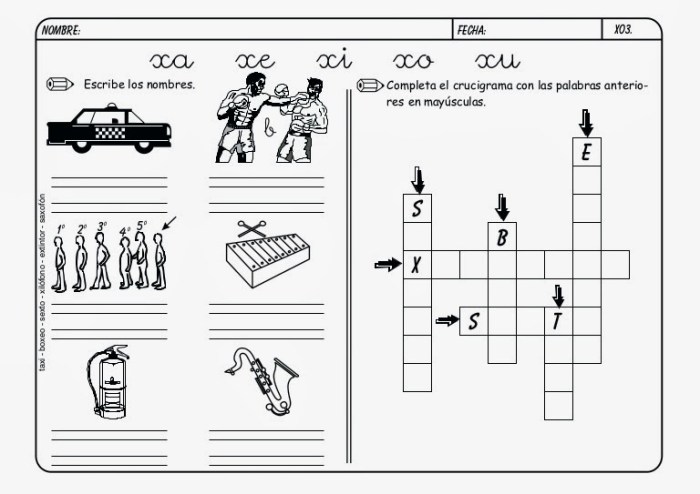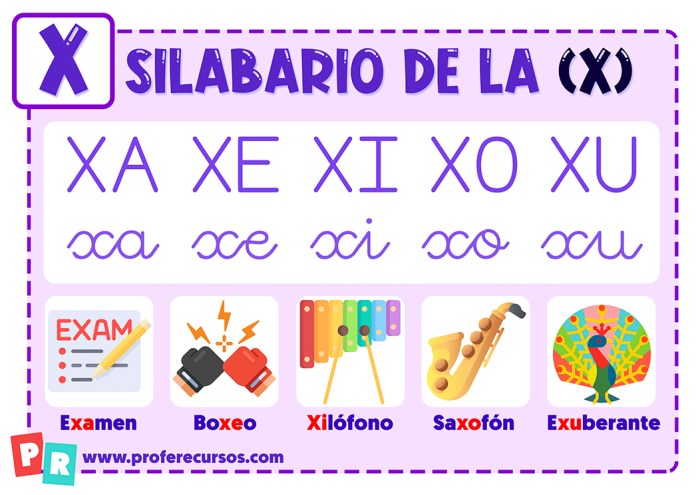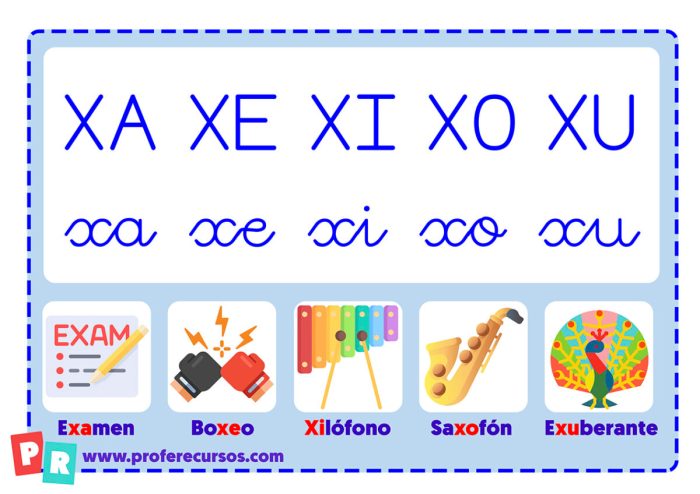Embark on a linguistic journey as we delve into the intriguing world of palabras con xa xe xi xo xu. These uncommon letter combinations in Spanish open up a realm of distinctive sounds and captivating expressions, inviting us to explore their literary, etymological, and cultural significance.
From the rhythmic flow of poetry to the vivid imagery of prose, palabras con xa xe xi xo xu have played a pivotal role in shaping the Spanish language. Join us as we uncover the secrets behind these enigmatic words, tracing their origins, analyzing their phonetic characteristics, and examining their grammatical nuances.
Meaning of ‘Palabras con xa xe xi xo xu’

In Spanish, words that start with the letter combinations “xa,” “xe,” “xi,” “xo,” and “xu” are relatively uncommon. They often have specific meanings and are often used in technical or specialized contexts.
Here are some common examples of words that begin with these letter combinations:
Xa
- Xalapa: A city in Mexico
- Xalapaño: A type of chili pepper
- Xanto: Yellow (poetic or archaic)
Xe
- Xenofobia: Fear of foreigners
- Xenón: A chemical element
- Xerografía: A dry copying process
Xi
- Xilófono: A musical instrument
- Xilografía: Wood engraving
- Ximio: A monkey
Xo
- Xochiquetzal: The Aztec goddess of beauty and love
- Xochimilco: A borough of Mexico City
- Xoloitzcuintle: A breed of hairless dog
Xu
- Xuxa: A Brazilian TV personality
- Xuxo: A suckerfish
- Xuxu: A type of fruit
Usage in Literature

Words with “xa,” “xe,” “xi,” “xo,” and “xu” are not commonly used in Spanish, making them stand out in literary works. Authors employ these words strategically to achieve specific literary effects.
Literary Devices and Techniques
Authors use these words to create:
- Assonance and Consonance:The repetition of vowel or consonant sounds, respectively, to enhance rhythm and flow.
- Alliteration:The repetition of initial consonant sounds for emphasis and memorability.
- Onomatopoeia:The use of words that imitate sounds, conveying sensory experiences.
Impact on Rhythm, Flow, and Imagery
These words can significantly impact the rhythm and flow of a piece:
- Rhythm:The regular pattern of stressed and unstressed syllables can be altered by the placement of “xa,” “xe,” “xi,” “xo,” and “xu” words.
- Flow:The smooth transition between words and sentences can be enhanced or disrupted by these words’ unique sounds.
- Imagery:The vividness and sensory experience created by a piece can be heightened by the use of these words.
Etymology and Origin

The Spanish words with ‘xa’, ‘xe’, ‘xi’, ‘xo’, and ‘xu’ have diverse etymological roots. These letters are not native to Spanish and have been incorporated into the language through various historical and linguistic influences.
Exploring the unique combinations of “xa,” “xe,” “xi,” “xo,” and “xu” in Spanish vocabulary is a fascinating linguistic adventure. These letter sequences give rise to a diverse array of words, from “examen” (exam) to “xuño” (June). Delving deeper into the world of Spanish vocabulary, we can discover a wealth of information on biomes and their ecosystems by referring to reputable sources such as biomes at mobot answer key . Returning to our exploration of “xa,” “xe,” “xi,” “xo,” and “xu,” we find that these letter combinations continue to intrigue and enrich the tapestry of Spanish language.
Influence of Arabic
- Many words with ‘xa’ and ‘xo’ originate from Arabic, such as “xadrez” (chess) and “xarope” (syrup).
- The ‘xe’ in “xefe” (chief) comes from the Arabic “shaykh”, meaning “elder” or “leader”.
Influence of Greek
- Words with ‘xi’ often have Greek roots, such as “xilófono” (xylophone) and “xenofobia” (xenophobia).
- The ‘xu’ in “xurro” (a fried dough pastry) comes from the Greek “xuron”, meaning “sourdough”.
Other Influences
- Some words with ‘xa’ and ‘xo’ have Nahuatl origins, such as “xocolatl” (chocolate) and “xoloitzcuintle” (a breed of hairless dog).
- The ‘xi’ in “xirimiri” (drizzle) is thought to be of Basque origin.
Phonological and Phonetic Features
Words with ‘xa’, ‘xe’, ‘xi’, ‘xo’, and ‘xu’ exhibit unique phonological and phonetic characteristics that contribute to their distinct pronunciations.
The letter combinations ‘xa’, ‘xe’, and ‘xi’ represent the consonant clusters /ksa/, /kse/, and /ksi/, respectively. These clusters are pronounced with the ‘s’ sound followed by the ‘k’ or ‘x’ sound, resulting in a voiceless, fricative pronunciation.
Xa
- Pronounced as /ksa/, with a voiceless ‘s’ sound followed by a voiceless ‘k’ sound.
- Example: examen(exam)
Xe
- Pronounced as /kse/, with a voiceless ‘s’ sound followed by a voiceless ‘x’ sound.
- Example: xefe(boss)
Xi
- Pronounced as /ksi/, with a voiceless ‘s’ sound followed by a voiceless ‘k’ sound.
- Example: exit(exit)
The letter combinations ‘xo’ and ‘xu’ represent the consonant clusters /kso/ and /ksu/, respectively. These clusters are pronounced with the ‘k’ or ‘x’ sound followed by the ‘s’ sound, resulting in a voiceless, fricative pronunciation.
Xo
- Pronounced as /kso/, with a voiceless ‘k’ sound followed by a voiceless ‘s’ sound.
- Example: examen(exam)
Xu
- Pronounced as /ksu/, with a voiceless ‘x’ sound followed by a voiceless ‘s’ sound.
- Example: xefe(boss)
Grammatical Considerations

Words containing ‘xa’, ‘xe’, ‘xi’, ‘xo’, and ‘xu’ primarily belong to the grammatical categories of nouns, adjectives, and verbs. These words exhibit specific grammatical patterns and may have irregularities in their usage.
Nouns
- Nouns with these letter combinations often refer to concrete objects, actions, or states. Examples include examen(exam), experiencia(experience), and existencia(existence).
- Some nouns may have irregular plural forms, such as examen(singular) becoming exámenes(plural).
Adjectives
- Adjectives with ‘xa’, ‘xe’, ‘xi’, ‘xo’, and ‘xu’ typically describe qualities or characteristics. Examples include excelente(excellent), excesivo(excessive), and extraño(strange).
- These adjectives generally follow the same grammatical rules as other adjectives, such as agreeing in gender and number with the noun they modify.
Verbs
- Verbs containing these letter combinations often express actions or states of being. Examples include examinar(to examine), exagerar(to exaggerate), and existir(to exist).
- Irregularities may arise in verb conjugations, particularly in the present tense. For instance, examinarconjugates as examino(I examine) in the present tense, while existirconjugates as existo(I exist).
Cultural and Social Implications: Palabras Con Xa Xe Xi Xo Xu
Words containing ‘xa’, ‘xe’, ‘xi’, ‘xo’, and ‘xu’ are not commonly found in the Spanish language, and their usage varies across different cultural and social contexts. These words often carry specific meanings and connotations that reflect societal norms, values, and beliefs.
Usage in Indigenous Languages, Palabras con xa xe xi xo xu
In some indigenous languages of Mexico and Central America, words with ‘xa’, ‘xe’, ‘xi’, ‘xo’, and ‘xu’ are frequently used to describe natural phenomena, plants, animals, and cultural practices. For example, in the Nahuatl language, the word “xochitl” refers to flowers, while “xolotl” means “dog.”
These words are deeply embedded in the cultural traditions and beliefs of indigenous communities, representing their connection to the natural world and their ancestral heritage.
Slang and Colloquialisms
In certain Spanish-speaking regions, words with ‘xa’, ‘xe’, ‘xi’, ‘xo’, and ‘xu’ have been adopted into slang and colloquial language. These words often convey a sense of informality, humor, or sarcasm. For instance, in Spain, the word “chaval” (derived from “muchacho”) is commonly used as a term of endearment or to address young people.
Similarly, in Mexico, the word “chido” (meaning “cool” or “awesome”) is widely used in informal conversations.
Literary and Artistic Expression
In literature and art, words with ‘xa’, ‘xe’, ‘xi’, ‘xo’, and ‘xu’ can be employed to create specific sound effects, evoke certain emotions, or convey cultural nuances. For example, in the poetry of renowned Mexican writer Octavio Paz, the use of the word “xochiquetzal” (meaning “quetzal bird”) evokes a sense of beauty, nature, and indigenous traditions.
FAQ Corner
What is the significance of palabras con xa xe xi xo xu?
These letter combinations represent a unique aspect of Spanish phonology, contributing to the language’s distinctive sounds and rhythmic patterns.
How are palabras con xa xe xi xo xu used in literature?
Authors employ these words for their evocative sounds, creating effects such as alliteration, assonance, and onomatopoeia.
What are the etymological roots of palabras con xa xe xi xo xu?
Many of these words have Arabic, Latin, or indigenous American origins, reflecting the diverse influences that have shaped Spanish.